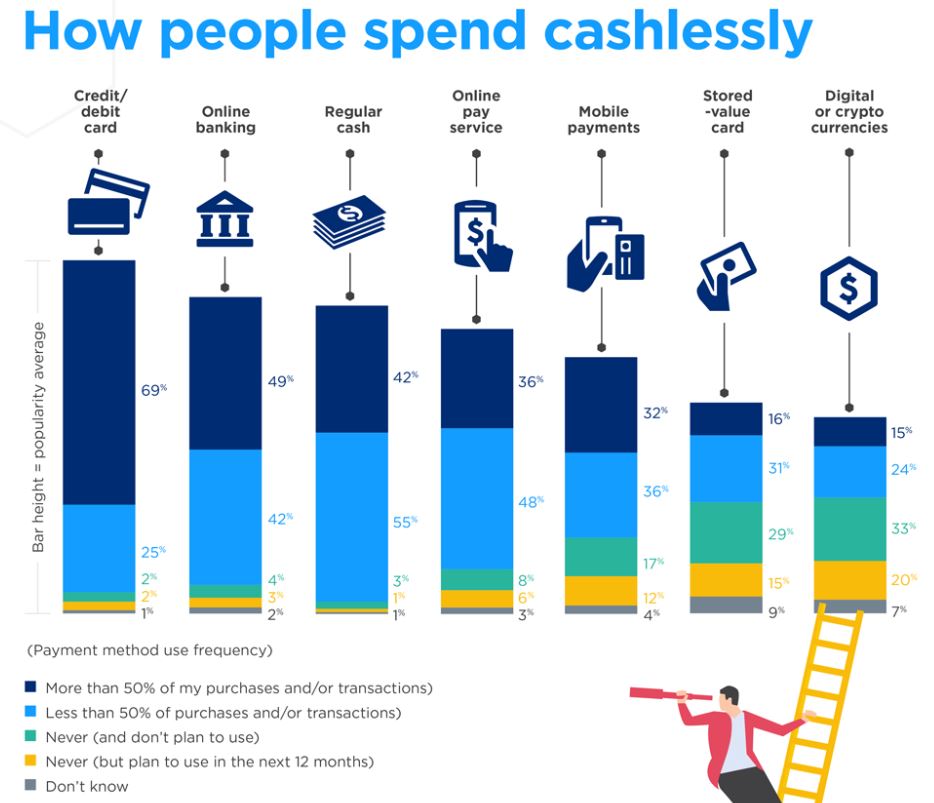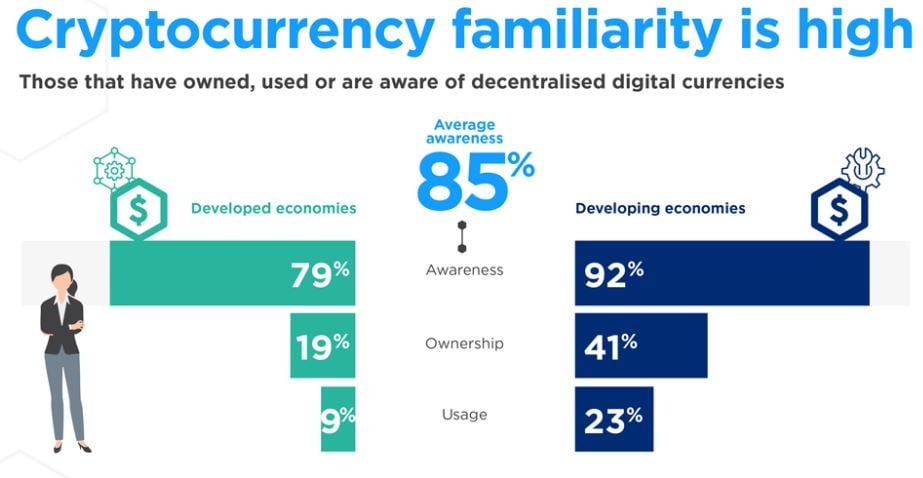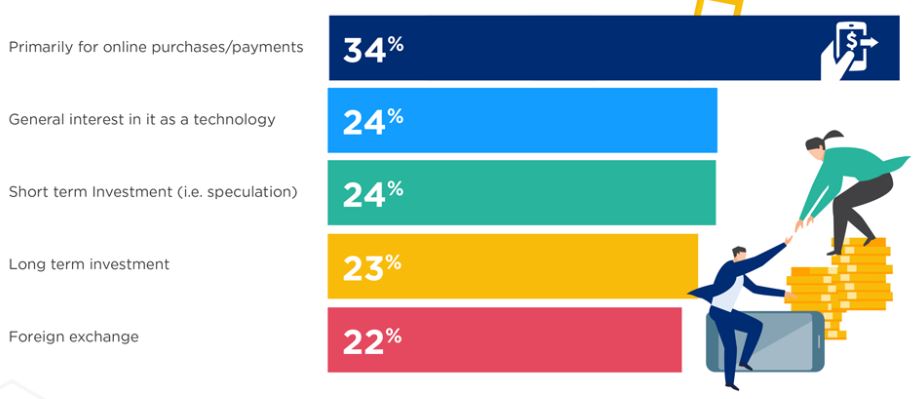A Cashless Future Foreshadows Cryptocurrency Mass Adoption
The world is already moving away from cash. Is Bitcoin and cryptocurrency the logical next step?

Key Takeaways
- Most people think that physical cash will become a less common way to pay for things in the near future.
- Digital payment methods like online banking, mobile, and cryptocurrency are quickly gaining traction.
- More than 85% of people surveyed are familiar with cryptocurrency, showing that awareness is rapidly growing.
- Developing economies are more than twice as likely to own and use cryptocurrency compared to developed economies.
Share this article
The world is quickly moving away from cash for payments. The trend shows promise for long-term Bitcoin and cryptocurrency adoption.
In joint research between The Economist Intelligence Unit and Crypto.com show that attitudes towards cash are quickly changing.
The study surveyed 3,000 people worldwide, and the results are startling. People are quickly ditching cash for credit cards and digital forms of payment, like Bitcoin. This isn’t limited to the United States or Europe, either. The trend is happening worldwide, with developing economies leading the way.
Toward a Cashless Future
The survey found that two-thirds of people use digital payments for more than half of their purchases. Of those who didn’t, one in five reported an intention to do so in the following year.
It’s important to note that digital payments here exclude credit cards, further emphasizing the magnitude of the change that is happening. These kinds of payments include online banking, mobile apps like AliPay and Google Pay, and online transfers like PayPal and Bitcoin.
At the moment, credit and debit cards represent the most popular purchase method. Physical cash is third, while cryptocurrency is last.

However, the lesser popularity of Bitcoin and cryptocurrency shouldn’t be seen as a negative. Bitcoin was released in 2009, and it only started to gain mainstream traction in 2015, making it one of the fastest growing segments among those listed. Given cash’s downward trajectory in terms of popularity, it wouldn’t be far-fetched to think that crypto will one day eclipse cash for payments.
Replacements for Cash
Cash is on its way out. One out of ten respondents describe their country as “already cashless.” More than half of respondents said they are “very likely” to use digital payment as their primary way to pay for things.
Overall, seven out of ten respondents think that cash will become a less common way to transact.
A meager 4% of all respondents are likely to continue using cash. In the developing world, that fell to a mere 1%, indicating non-cash payments are favored by the unbanked and underbanked, which explains the popularity of cryptocurrency for payments in the developing world.
Overall, it’s the older generations in developed countries, where legacy banking is mature and trusted, who are resisting the move away from cash.
According to Statcounter, an analytics firm, “developing economies such as India, Indonesia, Turkey and China” are leading the world in mobile internet usage, with digital payments becoming the norm. Meanwhile, other develop economies, like Argentina and Venezuela, are seeing rapid adoption of Bitcoin in the face of hyperinflation.
Bitcoin and Cryptocurrency in Payments
Although cryptocurrency currently lags behind other payment methods, familiarity with Bitcoin and other coins is becoming ubiquitous. Of those surveyed, a stunning 85% have heard of permissionless cryptocurrency.
The study shows that awareness is even higher in developing countries. Developing economies are more than twice as likely to own and use cryptocurrency compared to their developed counterparts. These figures support the narrative that crypto can help serve the poorly-banked.

The largest use-case for Bitcoin, according to the survey, is for online purchases and payments. However, between short and long-term investors, nearly half of people also see Bitcoin as an investment asset.

The benefits of digital forms of payment include greater efficiency, lower costs, greater convenience, and better access for the underbanked.
Meanwhile, governments are more interested in Bitcoin’s role in helping eliminate black market traade, thanks to the immutability and traceability of its blockchain ledger.
Obstacles to wider adoption remain, however. Privacy is a huge decision-making factor for users. Two-thirds of respondents said privacy was an “extremely important” factor for electronic payments.
Many respondents also expressed concerns over security, with fears of cybercrime remaining a problem. These problems extend to merchant adoption as well.
Antony Lewis, author of “The Basics of Bitcoins and Blockchains” said that a basic understanding of how cryptocurrencies worked was still an important step to mass adoption.
Another factor working in cryptocurrency’s favor is the recent coronavirus pandemic. As the Economist noted:
“The Louvre… banned cash at its ticket gate due to fears that banknotes could be COVID-19 vectors. The same caution has been taken globally as China, South Korea and the U.S. have all taken steps to quarantine or remove cash from circulation… COVID-19 has unexpectedly presented a whole new incentive to digitise money.”
Digital payments are opening the gateway for crypto. Now, the COVID-19 pandemic could well prove a tipping point for a cashless future. The trend is clear. In another generation it’s likely that online, mobile, and cryptocurrency payments will become the norm.
Disclosure: Crypto.com is a sponsor of Crypto Briefing.
Share this article
